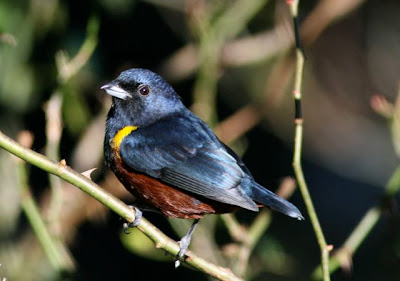Up we went, along a rough mountain road, bouncing over rocks and ruts, some of us regretting that extra cup of coffee and the effect it was having on our jostled bladders. But we were after birds in these mountains and we were willing to put up with some discomfort for the chance to see them.
Along shaded portions of the roadside, impatiens in various shades from pale pink to purple, grew wild, like a ground cover. I thought about how many hanging baskets I'd bought featuring these same flowers. Farther along the road we saw two workers weed-whacking the impatiens to keep the roadside clear.
At certain points in the road, the forest fell down the mountainside and we noticed clouds below us.
Among our quest birds was a Brazilian specialty known as the plovercrest. The plovercrest is a tiny hummingbird found in southeastern Brazil (and parts of Paraguay and Argentina) whose primary field mark is—you guessed it—a plover-like crest. In Brazil, this bird is known by the name beija flor de topete (tufted flower kisser).
Paulo first located the birds by hearing a singing male. This species forms loose leks where males gather to sing and flash their gorgets, hoping to attract a female. After hearing two or three males from the edge of the forest along the road, Paulo got us out of the bus and began scanning for the birds. He soon found the tiny singer and we all took turns standing in the exact place where you could see it through a hole in the thick vegetation. This was how the first bird looked (to my camera):
I was determined to try to get a photo of this bird, which I'd never heard of before I began prepping for this birding trip to Brazil. So I stepped softly into the shadows and began stalking another singing male. I could hear their chattery squeaks sounding so close, yet the tiny green birds were unbelievably hard to spot.
I found a single male and got a single frame of him before he split. I plunged deeper into the woods, heading in the direction of more calling plovercrests. For all I knew they might just be forest furies luring me to my death. This did not stop me. In a few years, some campesino would hack down a vine with his machete and reveal some bleached bones, thick dark glasses frames, a pair of Keen sandals, and a really nice pair of Leica 10x binoculars.
I heard human shouting.
From back out on the road, Paulo was shouting my name, saying he had a plovercrest that was just dying to have its photograph taken. I stumbled out into sunlight.
 Terry Moore waved me over to the spotting scope. There he was. Out in indirect sunlight, stretching, singing, yawning, pooping, then singing some more.
Terry Moore waved me over to the spotting scope. There he was. Out in indirect sunlight, stretching, singing, yawning, pooping, then singing some more.I soaked him in with my eyes, then stepped a few feet closer to take a dozen quick digital frames before he buzzed away.
Our plovercrest quest was a big success. I looked at my watch. It was 8:45 am. We had a LOT of birding yet to go.





























































